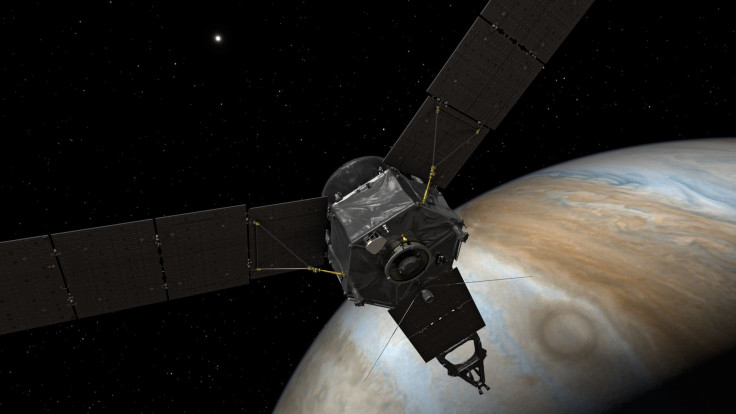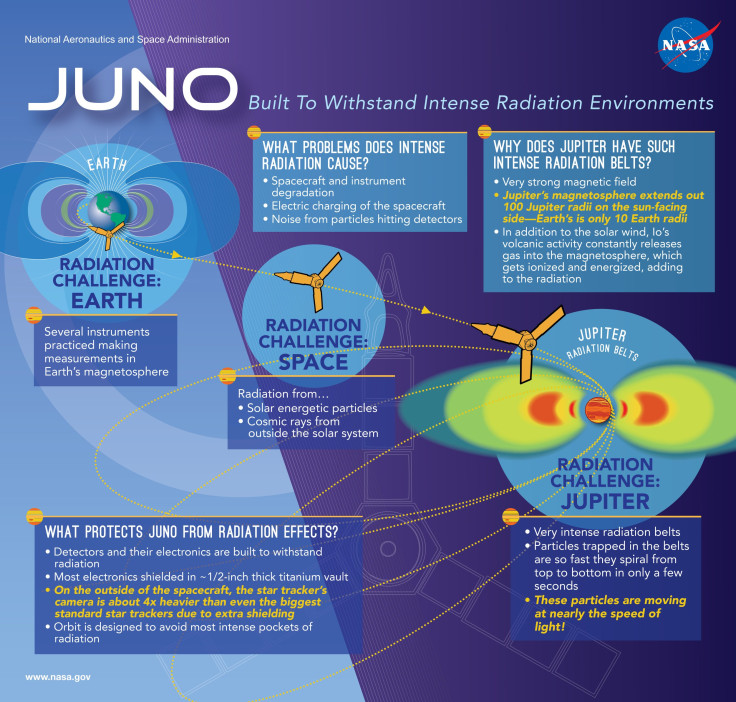NASA’s Juno Mission Live Stream: Solar-Powered Spacecraft Nears Jupiter After Five Year Voyage

After a nearly five-year-long journey during which it trekked through 1.8 billion miles of space, NASA's Juno spacecraft is finally bearing down on Jupiter. The solar-powered spacecraft, launched in August 2011, will begin a critical orbit insertion maneuver on Monday evening, which, if successful, would place it in orbit around the largest planet in our solar system.
"We are ready," Scott Bolton, principal investigator of Juno from the Southwest Research Institute in San Antonio, said in a NASA press release. "The science team is incredibly excited to be arriving at Jupiter. ... Jupiter is spectacular from afar and will be absolutely breathtaking from close up."
The spacecraft, equipped with nine science instruments designed to look through Jupiter's thick veil, will initiate a series of steps at 9:16 p.m. EDT in preparation for a main engine burn that will guide it into orbit around the fifth rock from the sun.
Then, a 35-minute orbit insertion process will begin at 11:18 p.m. EDT — a maneuver that can be seen live on NASA TV. However, given that light — and radio signals — take about 48 minutes to travel from Jupiter to Earth, the data transmission will not be instantaneous.
The spacecraft's science instruments will be turned on nearly 50 hours after orbital insertion. However, it will not begin collecting science data until the final burn of the main engine on Oct. 19, when it will shift into a highly-elliptical 14-day orbit from its initial 53.5-day-long orbit.
Juno, named after the Roman god Jupiter's wife, will spend the better part of the next 18 months trying to peer through the thick clouds surrounding the massive gas giant. The primary goals of the $1.1 billion mission are to find out whether Jupiter has a solid core, and whether there is water in the planet's atmosphere — something that may not only provide vital clues to how the planet formed and evolved, but also to how the solar system we live in came into existence.
"To accomplish its science objectives, Juno will orbit over Jupiter’s poles and pass very close to the planet. Juno needs to get extremely close to Jupiter to make the very precise measurements the mission is after," NASA explains. "The spacecraft will orbit Jupiter 37 times, with de-orbit into Jupiter at the end of the last orbit. During the almost one-and-a-half-year science phase of the mission, the spacecraft will execute a close flyby above the planet’s cloud tops every 14 days."
Much like Earth's Van Allen radiation belt — created due to the interaction of charged particles and the planet's magnetic field — Jupiter is surrounded by intense radiation fields. However, unlike Earth's radiation belts, Jupiter's are far more deadly.

"Everything about Jupiter is extreme; it's a planet on steroids. It has the harshest radiation of any planetary environment in the entire Solar System; it has the strongest magnetic field; it's spinning around incredibly fast," Bolton told the BBC. "We have to deal with this environment, and the spacecraft is literally an armored tank."
This armor — made of titanium — ensures that the sensitive electronics on board the spacecraft are not fried when it swoops within 3,000 miles of Jupiter's clouds.
Once it completes its mission, Juno will dive into Jupiter's atmosphere and burn up — a "deorbit" maneuver that is necessary to ensure that it does not crash into and contaminate the Jovian moons Europa, Ganymede and Callisto.
© Copyright IBTimes 2024. All rights reserved.






















